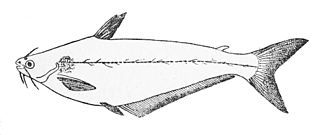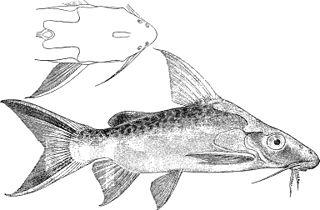
Bagarius is an Asian genus of catfishes of the family Sisoridae. It includes five to six extant species and potentially one extinct fossil species, B. gigas.
Breitensteinia is a genus of catfishes of the family Akysidae. It includes three species.

Synodontis batensoda, the upsidedown catfish, is a species of mochokid upside-down catfish. It is unevenly distributed in inland waters across Africa from Senegal to Ethiopia, and is also known as a squeaker or giant upside-down catfish. It was originally described by Eduard Rüppell in 1832 in the paper "Continuation of the description and figure of several new fish, in the Nile. p1-14".

The African butter catfish is a species of fish in the family Schilbeidae. It is native to many major river systems in Africa. Other common names for the fish include butter fish, butter barbel, African glass catfish, lubangu, mystus catfish, silver barbel, and silver catfish. It was originally described as Silurus mystus by Carl Linnaeus in 1758.
Synodontis afrofischeri, known as Fischer's Victoria squeaker, the marbled Victoria squeaker, Fischer's catfish, or the Victoria synodontis, is a species of upside-down catfish native to Kenya, Rwanda, Tanzania and Uganda. It was first described by German zoologist Franz Martin Hilgendorf in 1888, based upon a holotype discovered in Lake Victoria. The specific name "afrofischeri" is in honor of the German researcher Dr. Gustav Fischer, a German explorer of Africa.

The Lake Victoria squeaker is a species of upside-down catfish that is native to Kenya, Burundi, Tanzania and Uganda where it is found in Lakes Kioga and Victoria and the Victorian Nile the lower Kagera River and the Malagarasi River drainage. It was first described by British-Belgian zoologist George Albert Boulenger in 1906, from specimens collected in the Lake Victoria at Buganga, Uganda and Entebbe, Uganda by Mr. E. Degen. The species name victoriae is derived from the location where the species was originally discovered, Lake Victoria.

The longfin trevally, also known as the longfin kingfish, longfin cavalla or armed trevally, is a species of inshore marine fish in the jack family, Carangidae. The species is common in tropical to subtropical waters of the Indo-Pacific, ranging from South Africa in the west to Japan in the east, typically inhabiting inshore reefs and bays. The species is easily distinguished by its elongate dorsal and anal fin lobes and filamentous dorsal rays, as well as its scaleless breast. Longfin trevally are pelagic predators, taking a variety of small fish, cephalopods and crustaceans, and reach sexual maturity at around 21 cm. The species has a maximum known length of 57 cm and weight of 3.5 kg. The longfin trevally has a very complex taxonomic history which is closely intertwined with another currently valid species, Carangoides ciliarius, which may yet prove to be synonymous. Longfin trevally are of minor importance to fisheries throughout their range and are considered good table fish, and are occasionally taken by anglers.

The coastal trevally, also known as the onion trevally, Japanese trevally or bluefin kingfish, is a species of inshore marine fish in the jack family Carangidae. The species is distributed throughout the tropical and subtropical waters of the Indian and west Pacific Oceans, from South Africa in the west to Japan and New Caledonia in the east, reaching as far south as Australia. The species is found on deep coastal reefs, both in schools and as solitary individuals, where they prey on small midwater organisms including crustaceans, small fish and cephalopods. The species is taken as bycatch in a number of fisheries throughout its range by a number of fishing methods and is of little commercial value, but is considered to be a good table fish. A mistype in the original volume in which Eduard Rüppell named the species led to the combination Carangoides caeruleopinnatus, which has incorrectly spread through the literature.
Malapterurus beninensis is a species of electric catfish native to the African nations of Angola, Benin, Cameroon, the Democratic Republic of the Congo, the Republic of the Congo, Equatorial Guinea, Gabon, Ghana, Nigeria and Togo. This species grows to a length of 22 cm (9 in) SL. Its habitat is lowland marshes, rivers, and lakes.

Synodontis batesii is a species of upside-down catfish native to rivers of Cameroon, the Democratic Republic of the Congo, Equatorial Guinea and Gabon. It was first collected by G. L. Bates and described by Belgian-British zoologist George Albert Boulenger in 1907, based upon holotypes discovered in the Dja River, near Bitye in Cameroon. The specific name "batesii" refers to the name of the collector of the first specimen.

Synodontis caudovittatus, known as the white-finned synodontis, is a species of upside-down catfish that is native to the Nile basin of Ethiopia, South Sudan, and Sudan. It was first described by British-Belgian zoologist George Albert Boulenger in 1901, from specimens collected in the White Nile, at the mouth of Lake No in South Sudan. The species name caudovittatus comes from the Latin word cauda, meaning "tail", and the Latin word vitta, meaning "stripe" and refers to the coloration of the tailfin.

Synodontis filamentosus, known as the longfin synodontis, is a species of upside-down catfish that is native to the basins of the Nile, Volta and Niger Rivers as well as the Chad Basin. It was first described by British-Belgian zoologist George Albert Boulenger in 1901, from specimens obtained near the mouth of Lake No, on the White Nile in Sudan. The species name filamentosus comes from the elongated rays of the dorsal and caudal fins.
Synodontis flavitaeniatus, known as the orangestriped squeaker, the chocolatestriped squeaker, the yellowstriped squeaker, and the pyjama Syno, is a species of upside-down catfish native to the Democratic Republic of the Congo and the Republic of the Congo where it is found in the lower and central Congo Basin. It was first described by Belgian-British zoologist George Albert Boulenger in 1919. The holotype was collected from the Ruki River at Eala, in the Democratic Republic of the Congo. The meaning of the specific name "flavitaeniatus" is "yellow stripes".
Synodontis pardalis is a species of upside-down catfish that is endemic to Cameroon where it occurs in the Dja River drainage. It was first described by British-Belgian zoologist George Albert Boulenger in 1908, from specimens collected in the Dja River in southern Cameroon. The species name pardalis is derived from the Greek word pardalis, which means "leopard", which refers to the spotted pattern on the fish.

Synodontis pleurops, known as the Congo squeaker, the bigeye squeaker, or the bug eyed synodontis, is a species of upside-down catfish native to the upper Congo Basin of Cameroon, the Democratic Republic of the Congo and the Republic of the Congo. It was first described by the Belgian-British zoologist George Albert Boulenger in 1899, based upon a holotype discovered at the Boyoma Falls, in the Democratic Republic of the Congo.

Synodontis robbianus, known as the russet synodontis, is a species of upside-down catfish that is native to Nigeria where it is found in the Cross and lower Niger Rivers. It was first described by John Alexander Smith in 1875, from specimens collected in the Calabar River, Nigeria. The species name robbianus is named after Rev. Alexander Robb, a Scottish missionary, who collected the original species samples.

Synodontis serratus, known as the shield-head squeaker, is a species of upside-down catfish that is native to the Nile basin of the Democratic Republic of the Congo, Egypt, Ethiopia and Sudan. It was first described by German naturalist and explorer Eduard Rüppell in 1829, from specimens obtained near Cairo, Egypt. The species name serratus comes from the Latin word serra, meaning "saw", which refers to the serrated pectoral spines of the species.

Synodontis sorex is a species of upside-down catfish that is widely distributed in the rivers of northern Africa. It was first described by German zoologist Albert Günther in 1864, from specimens obtained in the upper Nile River, near Khartoum, Sudan. The species name sorex comes from the Latin word for shrew or shrew-mouse, the allusion was not explained. It possibly describes the pointed snout or the long, slender teeth.

The Indian Scad, also known as the Northern mackerel scad, round scad, Russell's mackerel scad, slender scad or the three lined grunter, is a species of ray-finned fish of the genus Decapterus which is part of the family Carangidae and which occurs in the Indian Ocean. It has colonised the eastern Mediterranean through the Suez Canal. It is an important species in coastal fisheries throughout its range.
Synodontis woleuensis is a species of upside-down catfish native to Equatorial Guinea and Gabon. It was first described in 2008 by American zoologists John P. Friel and John P. Sullivan. The original holotypes were collected in the Woleu-Ntem Province, Gabon. The specific name "woleuensis" is derived from the Woleu River, where the specimens were originally collected.














